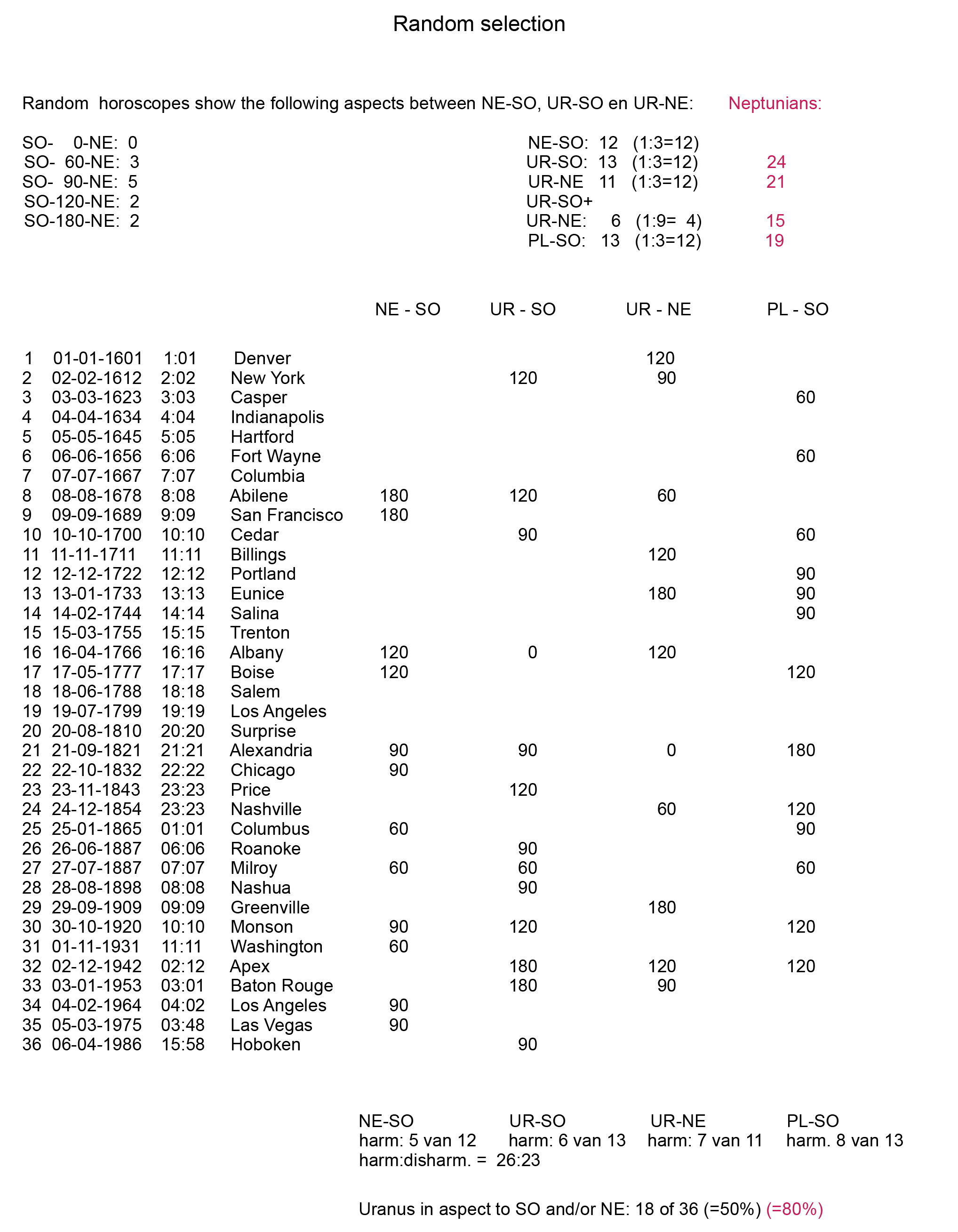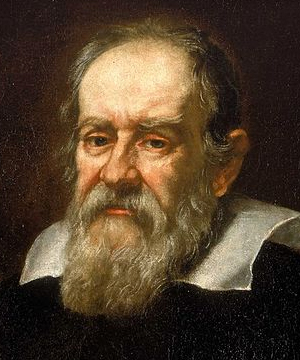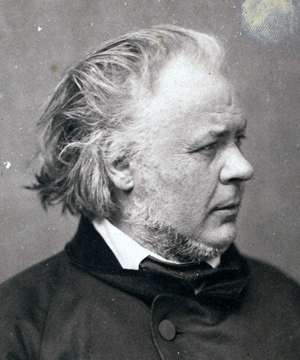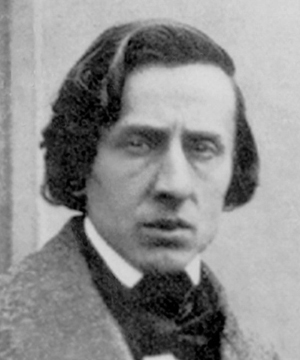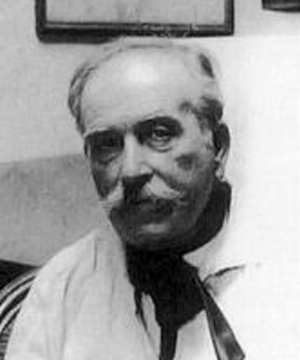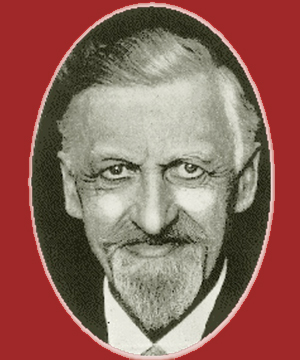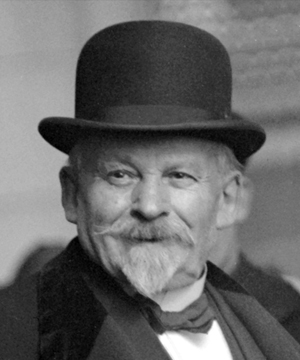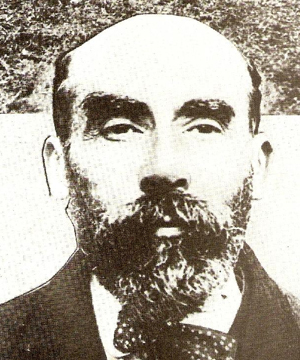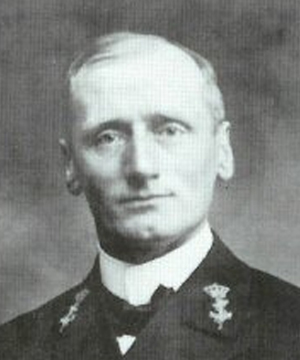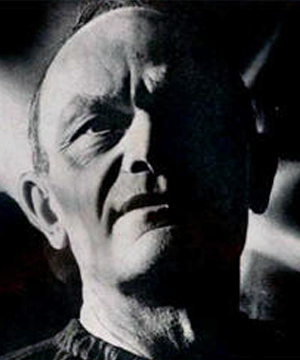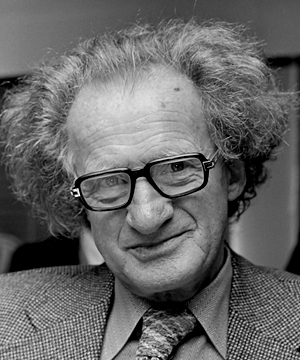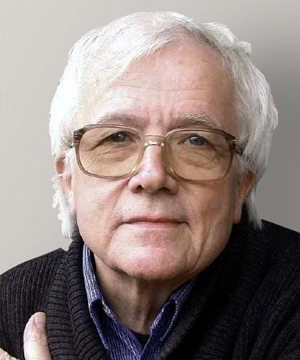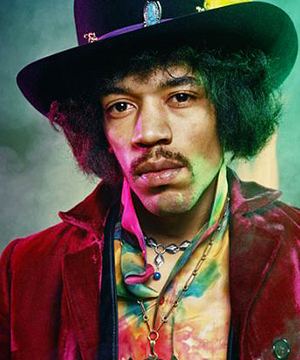Art and Cosmos
↓ Download this article
Can those born with a dominate Neptune in their birth chart be classified as Neptunians in the traditional astrological sense? The next question is: how to survive in this world as a Neptunian and, in particular, what are the determining factors for a Neptunian’s success in life?
From data of more than 1200 birth charts of well-known people I have selected 36 who share 2 or more of the following factors in their charts:
- Sun in major-aspect to Neptune, for almost all of them,
- if Sun in Pisces, and/or
- Neptune in Pisces, and/or
- Sun in 12, and/or
- Neptune in 12
Although there are possibly other factors in a horoscope that can create a Neptunian personality I am concentrating here on these 5 most obvious ones.
The data of 1200 horoscopes comes from “Cirkels, 800 horoscopen van bekende mensen” (transl. ‘Circles, 800 charts of famous people’) by the Dutch astrologer Jan Kampherbeek, plus 500 horoscopes of interesting characters for whom I have sieved through the complete alphabet of ‘Astrodienst’. In addition I used the German DAV data base containing many thousands of horoscopes, particularly useful as it has a search module attached.
Naturally these sources often contain the same famous persons. Therefore, from among the thousands of names and horoscopes I looked through, about 1200 to 1300 remained which I examined in respect to the above-named criteria.
To ensure the reliability of the material, I have only used horoscopes which are to be found on the site of Astro-Databank, since there the Rodden Rating is given. AA, A and B ratings are reliable to use in research. Lower ratings are also included on my list but are printed in light grey, to make a clear differentiation.
The selection of mainly well-known figures was an obvious choice due to the availability of biographies. You can click on a portrait to view their horoscope:
Content
While the emphasis in this study is on Neptune, I also describe the planetary significance of Uranus en Pluto. What makes astrological research especially interesting is that, in the process, you often discover more than you set out to find.
Neptune: ‘Lost in Space’,
Unlimited, infinite, cosmos, nirwana, maya,
spirit, soul, psyche, subconscious,
the unknowable, mystery, occultism, spiritism, divination, religion, gnostic, mercy, redemption, muse, imagination, inspiration, love, beauty, romance,
intuition, empathy, compassion, altruism, solace,
relaxation, memories, dreams, roaming,
confusion, solitude, escapism, addiction, paranoia, hypochondria arts, humanities.
Uranus: ‘Enlightenment’,
Discovery, invention, realization, liberation, emancipation, autonomy, humanism, originality, nonconformism, eccentric, revolution,
modernity, technology, futurism,
nervousness, restlessness, haste, noise,
science (beta-sciences).
Pluto: ‘To Be or Not To Be’,
Being, urgency, passion, transformation, stamina, domination, underworld.
It is not surprising that Neptune in its boundlessness holds such numerous concepts, while it would seem that Pluto is only about existence. Whereas Neptune is still dreaming in higher spheres and regularly in lower, Uranus awakens and insights occur which can lead to greater awareness. On the way all kinds of mishaps can occur because it concerns processes which we are not always able to comprehend. This engenders the need to expand our consciousness in order to avoid making the same mistakes over and again.
The Collection
Among the 36 horoscopes presented there are only 4 without a major-aspect between Sun and Neptune. I have chosen to include these in the list because they do contain 2 of the 5 factors which potentially make up a Neptunian. Handel is such an example, with his Sun and Neptune in Pisces. Although his chart has a too-low Rodden Rating, I have retained it because the two factors are not dependent on an exact hour of birth.This is also true of the horoscope of Rudolf Steiner. The birth chart of Lou de Palingboer also clearly shows these 2 factors and therefore is also included.
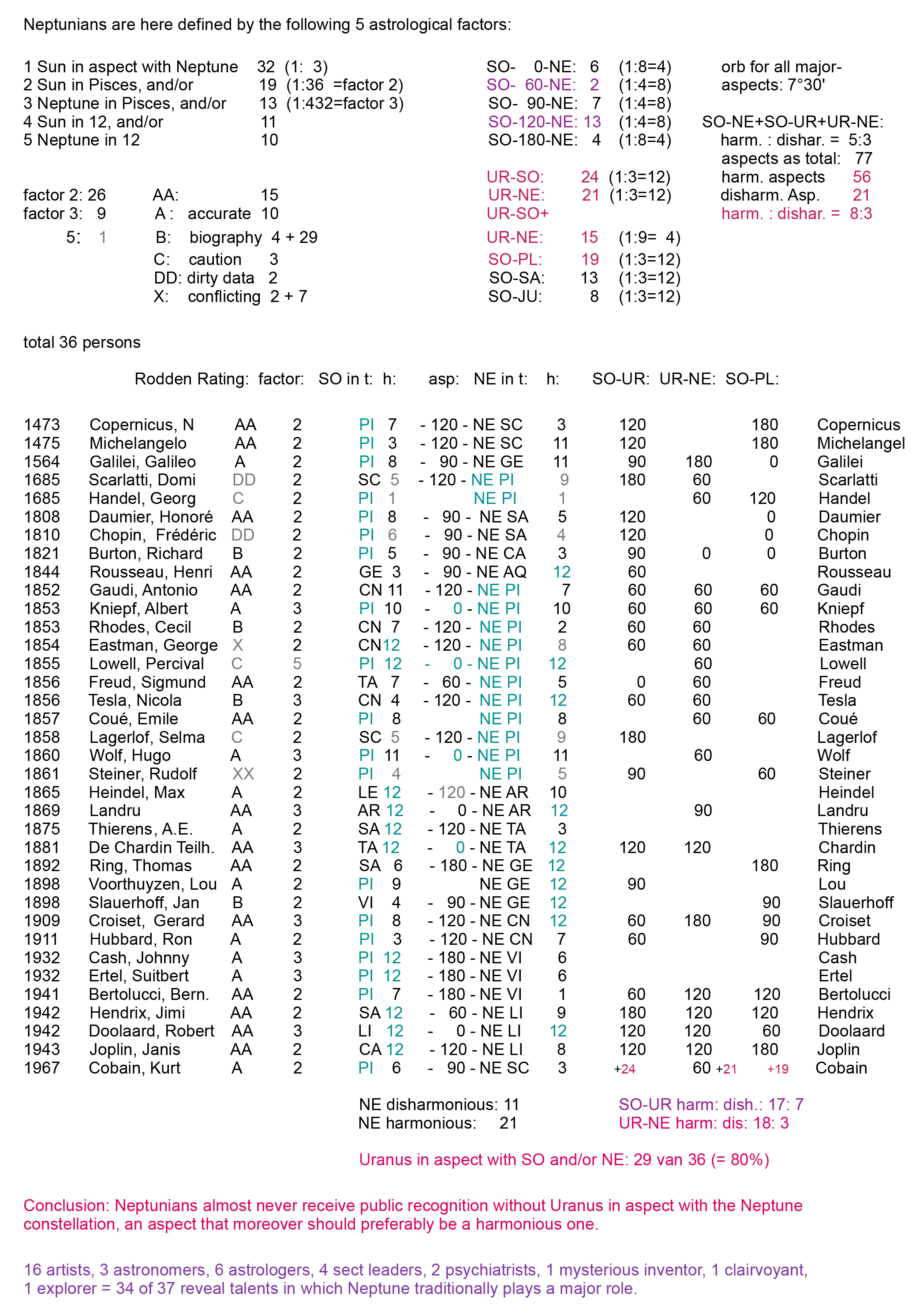
The orb
This is set at at 7°30′, adequate for all the major aspects except for the sextile, for which it is rather wide. The reason for this choice is as follows:
In total there are 8 aspects: outgoing: 0 – 60 – 90 – 120 – 180, incoming: – 120 – 90 – 60.
When all the orbs of these aspects are added together the result is: 8 x15°= 120°.
That means that the orbs cover 1/3 part of 360°, which indicates that there is a 1:3 chance that the Sun in a chart will form an aspect with Neptune.
The factors
The 1st factor has been described above. A second factor is e.g. Sun in Pisces. The level of chance here is 1:12. This is in general the same for Sun in 12. The resulting conclusion is that the chance of 2 factors is 1:36 (3×12).
In a similar way we can check whether this group of Neptunians are over- or under- represented. 36 x 36 = 1296. This is the estimated size the pool of selected horoscopes must be in order to extract from it the “36 factor 2 Neptunians”.
As I stated earlier, I consulted between 1200 and 1300 horoscopes for this study. Therefore the score of 36 lies within the estimated level, from which we can conclude that the Neptunians presented here are neither over- or under- represented.
So the 36 Horoscopes show 2 or more factors with a probability of 1:36 and of which 9 register a factor 3 with a probability of 1:432. That is also not extraordinary.
There is 1 with a factor 5. Here the probability is 1:3x12x12x12x12= 62.208.
That 1 horoscope has emerged with all these 5 factors is a wonder. This is that of Percival Lowell. Unfortunately the Rodden Rating C is a little too low, which gives an element of uncertainty to the positions in the 12th house.
The Aspects SO-NE
As illustrated above, there are 8 of these. Since both the conjunction and the opposition only occur once, that gives a probability ratio of 1 to 8=4. Therefore approximately 6 conjunctions and 4 oppositions would be in the line of expectancy.
The sextile and the trine differ in that there are 2 of each, an incoming and an outgoing and therefore that gives a probability of 1:4. Since this involves 32 SO-NE relations, the number to be expected for both is 8.
However, this collection of horoscopes only contains 2 sextiles but 13 trines. That is of itself remarkable, since it would indicate that talented Neptunians demonstrate a preference for the relation between mainly equal elements, in this case, water. But even with evidence of a clear preference for the trine as compared to the sextile, it remains complicated to measure exactly the uniqueness of this phenomenon.
Other Aspects
At the very beginning of this research, when I had as yet found only 15 horoscopes with a strong connection to Neptune, I already noticed that many of them revealed a major aspect between Sun and Uranus. This remained unchanged as my collection grew. The results are marked above to the right in red on fig. 2.
As has been discussed earlier, the probability of a major-aspect between 2 planets is 1:3. Therefore that should have resulted in12 SO-UR aspects. In fact there were 24!
This aroused my curiosity about the UR-NE and the SO-PL aspects. They also show a remarkable higher number than is to be expected. This gives food for thought.
However, I should first explain that another special characteristic of the named aspects is revealed on closer scrutiny, that is, the relation between the harmonious (soft) and disharmonious (hard) aspects.
The 8 major-aspects consist of 3 disharmonious aspects (1 opposition and the outgoing and incoming square) and of 5 harmonious aspects (the conjunction and the outgoing and incoming sextiles and trines). The relation is then 5:3 for harmony versus disharmony.
If we now take a look at the 32 SO-NE aspects, we discover 21 harmonious to 11 disharmonious. Nonetheless, it cannot be concluded that the number of harmonious aspects are over-represented as compared to the disharmonious. The relation 5:3 can be converted into 20:12 which is close to the factual 21:11.
The situation differs completely in the next columns of SO-UR and UR-NE. Here we see 45 registrations of which 35 are harmonious and therefore 10 disharmonious (35:10). That is a relation of 7:2. That means there are double the number of harmonious aspects than could be anticipated.
When adding the 4 columns of aspects together, the result comes to 77 registrations of which 56 are harmonious and 21 disharmonious. That shows a relation of 8:3 instead of 5:3.
Uranus clearly makes many aspects with the Sun and Neptune, about 2x as many as one would expect. And these aspects are also 2x so harmonious as “normal”.
The compilation of all this data forms the instigation for the conclusion, as set out in red at the bottom of fig. 2.
As comparison the end of this article shows 36 horoscopes that have been selected arbitrarily (fig. 3). In all of these the registrations are within expectations. Although this random choice would seem superfluous, I have chosen to include it for extra clarity and contrast.
I have also looked at the cycles of UR-PL, NE-PL, SO-SA, SO- JU. Nothing dramatic is discernable, with their respective 13, 12, 13 and 8 registrations.
That the NE-PL aspects gave no spectacular results came somewhat as a surprise. After all, this is the longest cycle of all the planets, nearly 500 years, and it is a pity for research that most relatively reliable horoscopes are from within the last cycle.
The relation between the Sun and the social planets of Saturn and Jupiter was unremarkable. It would seem that this is not an area of great importance for the Neptunian.
The Neptunian
The question now remains: to what extent are these Neptunians by birth neptunian?
Unfortunately no scale exists with which to measure the measurelessness, as there is also none to measure or weigh other neptunian characteristics.
However, when looking at their professions, it becomes clear that there is a high percentage of artists among these earlier-defined Neptunians. Two of the astrologers among them (Ring and Doolaard) were also artists, leading to a result of 18. A noticeably large percentage.
Who Not?
First let’s look at those professions which are under-represented on this list. It becomes obvious that “the world of power”, i.e. politicians, military leaders, etc. are not represented here at all. Also those from the world of sport, business and industry are not to be found among them. Nevertheless, there were 2 Neptunians who demonstrated a business sense, i.e. Cecil Rhodes and George Eastman.
Rhodes would not seem to be an obvious Neptunian. But just listen to his sighs of measureless imperialistic longing: “To think of these stars that you see overhead at night, these vast worlds which we can never reach. I would annexe the planets if I could; I often think of that. It makes me sad to see them so clear and yet so far.” Cosmic awe together with burning territorial passion.
He became immensely wealthy by his appropriation of diamond mines in Africa. Little loved for his dubious role in the colonial race for Afrika, his biographies reveal that in fact he was not without ethical values.
Eastman invented the filmrole for the camera and sold it under the brand Kodak. Thanks to this a cultural treasure of historical images have been preserved to enrich our memories. Very neptunian. He also established a School for Music and supported a symphony orchestra.
Landru, also a Neptunian, was someone I would have preferred not to include. He is everything one wishes not to become. This serial-murderer preyed on lonely women whose husbands were away fighting at the front (WW1).
However, it is for another reason that this horoscope is interesting. The Dutch researcher Jan Ruis has published a study of the horoscopes of serial murderers which reveal a remarkable number of planets in mutable signs and houses. What struck him most among these sad characters was Sun and Neptune in the 12th House. Landru has 7 of the 10 planets in a mutable house (12th and 3rd) and Sun conjunct Neptune in 12. He therefore fits exactly within Jan Ruis’ set criteria.
Neptunians galore
While astronomy is officially a science, astrology belongs to the humanities.
A quarter of the characters in the group of Neptunians were occupied with the cosmos, 3 of whom were astronomers and 6 astrologers.
Three-quarters of the list have now been seen to have a background of art and/or cosmos.
Sect leaders
To my surprise there were 4 sect leaders among the group of Neptunians, including Rudolf Steiner, Max Heindel, Lou de Palingboer and Ron Hubbard.
Heindel was a christian mystic and astrologer. In 1909 he established the Rosicrucian Fellowship.
Steiner, after leaving the Theosophical movement, established the spiritual-philosophical Anthroposophy.
Hubbard is known as an adventurer and spiritual conman.
The Dutchman Lou de Palingboer was a fishmonger, who loudly predicated his form of evangelism at the market. In the ’60’s a sect of brothers and sisters developed around him in Amsterdam. His wife Mien convinced him that he was Christ Resurrected and yes… God incarnate! Lou thought: “then you’ll see…” And he took full advantage of his supposed holiness! Resulting in an equally hilarious as tragic downfall.
Sigmund Freud, founder of psychoanalysis and author of Die Traumdeuting. Today still influential and controversial.
Emile Coué, also a psychotherapist, has largely been forgotten. He propagated optimistic self- hypnosis, as the means to bring about positive change in the human subconscious.
Nicola Tesla possessed such an extraordinary imagination that he could conjure up the detailed test of a prototype of his inventions and therefore speedily reach a result. As an idealist with a minimal commercial interest he was the complete opposite to Edison.
Tesla’s later inventions are enveloped with mystery and have sadly left him with the image of mad scientist. He was extremely shy, had a contamination phobia, neurotic ticks and an obsession with the number 3. An exceptional Neptunian with all the extreme positive and negative traits.
Gerard Croiset, para gnostic, spiritual healer and clairvoyant. His reputation became controversial after publications by sceptics, a caution when considering both the criticism and Croiset himself. During his lifetime he was respected, due partly to his cooperation with the para-pyschologist Wilhelm Tenhaeff in the legendary ‘chair test’.
Richard Burton, ‘Sir’ Richard – no less! This colourful figure was an explorer, geographer, translator, author, soldier, orientalist, cartographer, ethnologist, spy, linguist. poet, Egyptologist and diplomat. He undertook explorations in Asia, Africa and both America’s and is reputed to have been fluent in 29 languages. His translations include: A Thousand and One Nights and the Kama Sutra, to the shock of Victorian England. He was an opium and hashish user, as was quite common in the19th century, before it was banned.
Teilhard de Chardin, has largely disappeared into obscurity. He was a geologist and palaeontologist but was principally known for his evolutionary philosophy explained in his Le Phénomène Humain.
Although he was a Jesuit priest he was forbidden by a papal decree in 1944 to publish his work or teach his principles. It took until 2009 before this decree was retracted by Pope Benedictus XVI. Chardin was indisputably a man of profound insight and whose ideas are worth conserving.
Handel, Bach and Scarlatti:
These 3 composers from the Baroque era were all born in 1685 during a Uranus-60-Neptune in Pisces. That provides the opportunity to compare the constellations in their charts.
Handel has the New Moon and Neptune in Pisces. Scarlatti’s Sun is trine Neptune and opposite Uranus.
This leaves Bach, the composer who put the complete story of suffering into music but is not on the list of Neptunians. If the computer had made the data selection, Bach would certainly have been included. He had Neptune in Pisces and Sun in 12 (plus Moon conjunct Neptune). Sadly, his birth time is unsure so I had to leave him out.
Chopin‘s hour of birth is also not certain, but whatever it was his Sun is in Pisces, with an outgoing square to Neptune, and those are 2 of the required factors. He was a child wonder and great virtuoso in the Romantic era. For 10 years he had a turbulent relationship with the writer with the male pseudonym of George Sand. His public performances were rare, due to an extreme shyness.
Selma Lagerlöff. Whoever has not read her The Wonderful Adventures of Nils has missed something in their lives!
Jan Slauerhoff, poet, novelist and ship’s doctor. Struggled all his life with bad health. His largely magic realistic work reverberates in the aftermath as if the reader had dreamed it himself.
Albert Kniepf was a German scientifically-oriented astrologer. He introduced the concept of the ‘midpoints’.
Suitbert Ertel, Professor Emeritus, psychologist and astrologer. He studied the work of Gauguelin and was co-author of The Tenacius Mars Effect.
At the forefront of the group is Copernicus who introduced the heliocentric solar system, 1800 years after Aristarchus of Samos whose concept was too far in advance for his time.
Last on the list is Kurt Cobain, the lead singer with the melancholic voice from the group Nirvana.
He died under mysterious circumstances.
Perhaps it seems rather strange to compare the historic impact of someone like Copericus with that of a pop singer. Such a contrast occurs more frequently between individuals in this selection of Neptunians, especially if they died young, like the memorable Jimi Hendrix and Janis Joplin. I hesitate to make a judgement on the importance of their individual talents. There are, of course, differentiations, i.e. those whose Neptune is linked to Uranus and those without this connection. The contrast is clear.
You might wonder why I placed myself among the group. This was simply because I am a Neptunian with factor 3 and have always nurtured an interest in the talents and fate of other Neptunians. Thanks to the publication of the Rodden Files on the site of the Astro-Databank this collection of horoscopes was now available for research.
For further reading on other areas of my research, you can also have a look on the website of The Dutch Association for Scientific Research into Astrology (also in English): www.nvwoa.nl
By-catch
Two–thirds of the group of Neptunians listed above were born with an aspect between their Sun and Uranus and almost as many with an aspect between Uranus and Neptune. That is an exceptional ratio, about 2x as coincidence would allow. In addition the character of these aspects are mainly harmonious, also 2x as at random. This is the fascinating by-catch of this study.
Since most Neptunian revelations are in general as elusive as they are subtle, shooting directly from the collective and individual subconscious, as the lyrical desire for life and love, much can go wrong in the real world. The spirit is blown in every direction.
It is possible that when Uranus has a tense aspect to Neptune, one wakes up with a jolt from their neptunian dream to the kettle music of modernity.
Although harmonious aspects are often seen as engendering laziness, they can also provide talents of which you are hardly aware. I consider that the soft aspects of Uranus to the neptunian can bring a gentler awakening from the subconscious to the conscious state, where dream and creativity flow into one another, as a stream into the river. There is music. We are hopelessly addicted to this terrible and yet wonderful world…
(to be continued..)
© Robert D. Doolaard, Amsterdam February 2015
Comments
Copernicus does not appear to have had SO-120- NE. However, his Sun does trine the midpoint of the wide UR-NE conjunction, exact to within 1 degree. Therefore I have kept this horoscope on the list.
Michelangelo appears to lack SO-120-UR within the set orb, but is registered in his horoscope from the Astro-Databank. Uranus does make up part of a kite formation in which the Sun is included.
The Neptune of Max Heindel is on his MC, trine to the(almost) new moon.
Sources
The horoscope data comes from the Astro-Databank.
The horoscopes were made with the astrology programme “Digital Time Capsule” from Dusty Park & Co., San Francisco.
